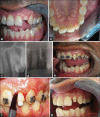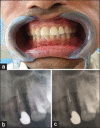Multidisciplinary approach to the management of complicated crown-root fracture: a case report
- PMID: 25954080
- PMCID: PMC4409806
Multidisciplinary approach to the management of complicated crown-root fracture: a case report
Abstract
Oblique crown-root fracture in the cervical third of the root is a common event following trauma to the anterior region of the mouth. As a result, sound tooth structure coronal to the attachment apparatus may not be available for restorative needs. Invasion of biological width by fracture line presents a clinical challenge in restorative planning. Placing a restoration margin on sound tooth structure within the dentogingival biological width might result in violation of biological width and should be considered a restorative failure. Maintaining a healthy periodontal attachment apparatus is crucial for long term prognosis and esthetics of the restored tooth. Surgical crown lengthening, surgical extrusion or orthodontic extrusions are the few alternative modalities to expose the fracture line. This case presentation demonstrates a predictable solution in overcoming an oblique crown-root fracture caused by trauma during a road accident. Orthodontic extrusion was used to elevate the fractured tooth from within the alveolar socket to allow the placement of crown margins on sound tooth structure without harming the biologic width. Combining fiberotomy with the extrusion procedure in this case eliminated the need for the surgical procedure. This allowed proper fabrication of post and core and the placement of the crown on sound tooth structure, fulfilling the biological and mechanical principles including obligatory ferrule effect.
Keywords: Circumferential supracrestal fibrotomy; Oblique crown root fracture; Orthodontic extrusion.
Conflict of interest statement
Figures


Similar articles
-
Combined treatment of surgical extrusion and crown lengthening procedure for severe crown-root fracture of a growing patient: a case report.BMC Oral Health. 2024 Dec 18;24(1):1498. doi: 10.1186/s12903-024-05277-4. BMC Oral Health. 2024. PMID: 39695631 Free PMC article.
-
Orthodontic extrusion of an extensively broken down anterior tooth: a clinical report.Quintessence Int. 2005 Feb;36(2):89-95. Quintessence Int. 2005. PMID: 15732544
-
The management of a complicated crown-root fracture incorporating modified crown-lengthening surgery.Br Dent J. 2021 Feb;230(4):217-222. doi: 10.1038/s41415-021-2653-4. Epub 2021 Feb 26. Br Dent J. 2021. PMID: 33637921
-
Restoring teeth following crown lengthening procedures.J Prosthet Dent. 1991 Jan;65(1):62-4. doi: 10.1016/0022-3913(91)90049-3. J Prosthet Dent. 1991. PMID: 2033546 Review.
-
Clinical Considerations in Orthodontically Forced Eruption for Restorative Purposes.J Clin Med. 2021 Dec 18;10(24):5950. doi: 10.3390/jcm10245950. J Clin Med. 2021. PMID: 34945246 Free PMC article. Review.
Cited by
-
Multidisciplinary Management of Complicated Crown-Root Fracture: A Case Report.J Dent (Tehran). 2018 May;15(3):193-196. J Dent (Tehran). 2018. PMID: 30090120 Free PMC article.
-
Surgical extrusion: A reliable alternative for saving fractured anterior teeth.SAGE Open Med Case Rep. 2021 Jul 29;9:2050313X211036780. doi: 10.1177/2050313X211036780. eCollection 2021. SAGE Open Med Case Rep. 2021. PMID: 34377489 Free PMC article.
-
Single- versus multi-visit approach for fragment reattachment in complicated crown-root fractures: a cohort study.BMC Oral Health. 2024 Sep 27;24(1):1129. doi: 10.1186/s12903-024-04880-9. BMC Oral Health. 2024. PMID: 39334222 Free PMC article.
-
Conservative Approach for Traumatic Anterior Crown-Root Fractured Teeth by Orthodontic Extrusion using Customized Mini-Tube Appliance: A Clinical Review.Case Rep Dent. 2023 Sep 12;2023:7911464. doi: 10.1155/2023/7911464. eCollection 2023. Case Rep Dent. 2023. PMID: 38130430 Free PMC article.
-
The Efficacy of Ozonated Olive Oil in Crown Lengthening Procedures for Anterior Teeth: A Case Report.Cureus. 2024 Aug 8;16(8):e66480. doi: 10.7759/cureus.66480. eCollection 2024 Aug. Cureus. 2024. PMID: 39247044 Free PMC article.
References
-
- Andreason JO, Andreason FM. Traumatic Injuries of Teeth. 2nd ed. Copenhagen: Saunders Publications, Munksgaard; 1988.
-
- Trushkowsky RD. Esthetic, biologic and restorative considerations in coronal segment reattachment for a fractured tooth: A clinical report. J Prosthet Dent. 1998;79(2):115–9. - PubMed
-
- Padbury A, Jr, Eber R, Wang HL. Interactions between the gingiva and the margin of restorations. J Clin Periodontol. 2003;30(5):379–85. - PubMed
-
- Olsburgh S, Jacoby T, Krejci I. Crown fractures in the permanent dentition: Pulpal and restorative considerations. Dent Traumatol. 2002;18(3):103–15. - PubMed
-
- Fournier A. Orthodontic management of subgingivally fractured teeth. J Clin Orthod. 1981;15(7):502–3. - PubMed
Publication types
LinkOut - more resources
Full Text Sources
Research Materials
